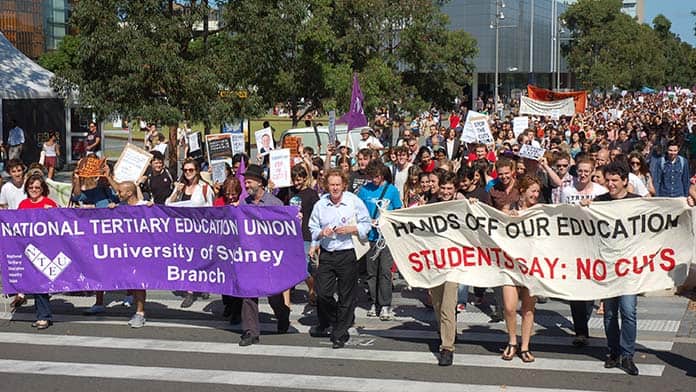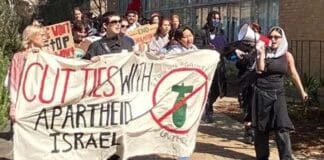How protest action stopped job cuts at Sydney Uni in 2012
Universities are currently facing a bloodbath—with thousands of jobs set to be cut across the sector.
But staff and students can fight back. In 2012, staff and student action at Sydney University saved hundreds of staff jobs.
In late November in 2011 Vice-Chancellor Michael Spence sent out a video explaining that university management was looking to cut up to $27 million in costs- starting with 340 staff who they assessed were less “productive” and therefore not valuable to the corporate university. The Refugee Language Program was seen as similarly expendable. Then, as now, similar cuts were being proposed in universities across the country.
Activists in Solidarity immediately called meetings through the Education Action Group (EAG) to mobilise students from affected departments and the existing campus left. Despite attempts from the education officers at the time to bureaucratically control the EAG, Solidarity members successfully argued that the collective needed to be democratically controlled by the students building the campaign.
The campaign involved broader layers of students beyond the existing left, who often packed out meetings. Throughout the campaign 30-60 students regularly attended meetings, taking seriously an ongoing commitment to the campaign and the debates necessary to collectively decide how to take it forward.
The success of the campaign was due to the mass building work of activists amongst the wider student body. Seventy motions against the cuts were passed in lectures to build a protest of 1500 students and staff. At the end of the rally, there was a 100-strong student occupation of the Dean of Arts office, which became a mass meeting which resolved to escalate the campaign of direct action.
This set the stage for a 250-strong student strike where eight classes walked out to join a lunchtime rally of 400, as well as a further rally outside the University Senate, where riot police were called in and dragged and threw students to the ground to stop them occupying the meeting.
Ultimately, the campaign managed to save 47 of the 100 jobs set to be cut, stopped a number of demotions to teaching-only positions and saved the refugee language program. We have also seen similar success last year in mobilising large numbers of students, through going to lectures and organising campaign stalls to build the Climate Strike mobilisations. With a similar mass, democratic, and disruptive approach today, we can push back the enormous job cuts we are facing on campus.
By Cooper Forsyth
How a student campaign saved jobs at Sydney College of the Arts
The campaign to save Sydney College of the Arts (SCA), the Sydney University art school at Callan park in Rozelle, shows the power of student activism and the gains that can be won through strategic, organised resistance.
In Semester 2 of 2016 the university attempted to close its art school by forcing students to move to the University of NSW, a plan that would have meant hundreds of job losses for staff at SCA and a significant reduction in the quality of education.
What was disguised as the creation of a “centre for excellence”, was in fact a cost cutting scheme as part of a university restructure aimed at reducing staff numbers and resource intensive subjects.
In response to the proposal, activists and SCA students and staff held a mass meeting of 250 people, which voted to hold a rally at the next University Senate meeting.
Four hundred people came to the rally, including representatives from multiple unions and Greens MP Jamie Parker. The first big win came shortly after, when the university terminated the merger and proposed moving SCA onto the main Camperdown campus, shattering the facade of the “centre for excellence” and exposing their true intentions.
Student activists helped to mount a rigorous campaign against the move, including multiple rallies and support actions across both SCA and Camperdown campuses, two student strikes, and a 65 day occupation of the administration offices at SCA, which was supported through union BBQs and “meet the occupiers” events.
The campaign was built through open democratic meetings that voted on all steps and escalations. For activists, a significant part of the task was publicising the meetings and getting people involved by holding stalls, leafletting the gates, making lecture announcements and having one-on-one conversations with students and staff.
The efforts of students and activists undoubtedly led to the campaign’s many victories.
However, one significant downfall of the campaign was its inability to involve staff and lecturers. Multiple factors contributed to this, including low union density at SCA and next to no support from union members on the main Sydney University campus.
This caused confusion around what staff were legally allowed to do, with many being too afraid to speak out against the university for fear of repercussions.
Organisation amongst the staff was also burdened with in-fighting about how the art school should run rather than discussion of how to fight the university.
While the student strikes successfully disrupted SCA (some classes were cancelled, the university looked bad, and the action got some media attention), a staff strike would have impacted the university in a way that the student strike could not.
If this had happened in conjunction with industrial action from staff on main campus it would have benefitted both SCA staff and all Sydney University staff, who would have been in a much stronger position the next year going into EBA negotiations. The lesson, as in any uni campaign, is figuring out ways to move beyond simply student involvement to involve university workers.
Nonetheless, the SCA campaign won significant gains: the merger was scrapped, the Dean Collin Rhodes was forced to resign, the university capitulated to students remaining at the Rozelle campus for three more years, all the studios were saved and 50 per cent more staff kept their jobs than initially proposed.
The Save SCA campaign was an amazing example of what radical student organising can look like and achieve, and the power that students have to fight the corporate university.
Significantly, it showed what happens when you reach a broad base of students and inspire them to be active and take up their own struggle.
By Thandi Bethune
Read the Solidarity pamphlet The art of struggle: Lessons from the fight to save SCA here






